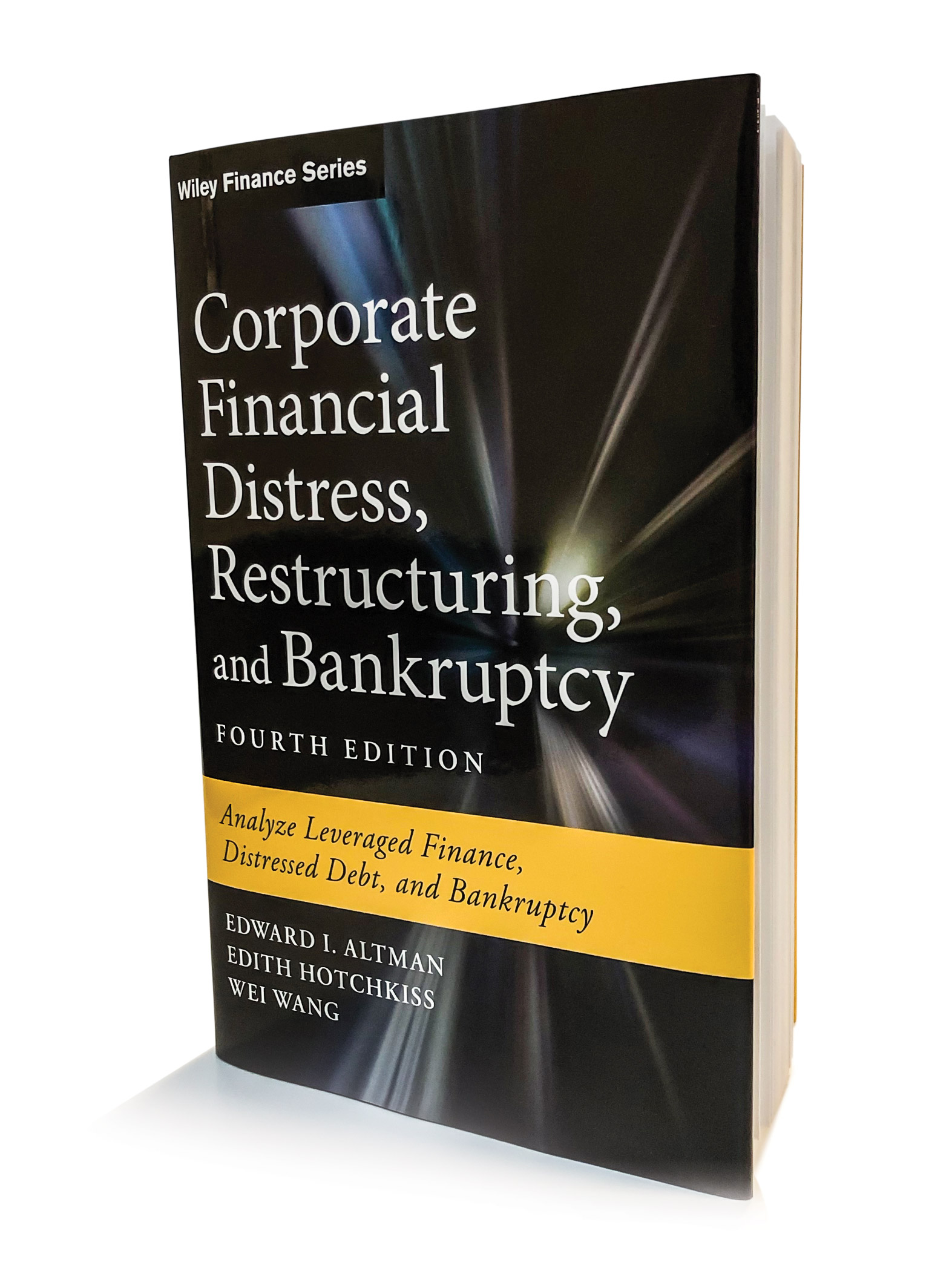The good, the bad & the distressed

Back in March, on a giant screen in Goodes Hall, Wei Wang, PhD’06, shared a blast from the past with his audience – a Radio Shack flyer from 1991. The ad featured a typical assortment of items sold back then by the electronics chain: cassette player, camera, telephone, radio, calculator and video recorder. Radio Shack went into bankruptcy protection in 2015 and, again, in 2017. Looking at the ad now, Radio Shack’s fall seems unsurprising. “Every item here was replaced by one product,” Wang told a packed house of students and faculty. “The smartphone.”
Some companies, like Radio Shack, appear doomed to fail as consumer trends, technology and the creative destruction always churning within the economy drives them to obsolescence. But there’s good news in bankruptcy, too. Most companies survive. And a growing bankruptcy industry not only creates a path for firms to emerge successfully, it generates efficiencies, value and, for some, such as distress investors, profits.
Wang, director of Smith’s Master of Finance-Beijing program and an associate professor and RBC Fellow of Finance at the school, gave the talk on bankruptcy, his area of expertise, to mark the publication of the fourth edition of perhaps the definitive textbook on the subject: Corporate Financial Distress, Restructuring, and Bankruptcy [Wiley]. The first-time co-author calls the bankruptcy industry a “black box” that most people know little about. Smith Magazine recently spoke with him about his book and research into the field.
Let’s talk about the economy right now. It seems strong, but what dangers, if any, do you see ahead?
Corporate debt is one. As of today, in the U.S. market alone, we’re standing on US$2.7 trillion worth of high-yield bonds and leveraged loans. That’s a record high. We’ve never seen that in history, not even before the financial crisis. I’m not talking about the housing market. This is corporate debt to highly risky companies. Those companies have double-B, single-B or even lower credit ratings. So in the next recession, a lot of those loans and bonds will be in a default state.

Professor Wei Wang's new book
The introduction to your book mentions that, over the last few decades, we’ve seen the emergence of a ‘bankruptcy industry’.
Why has that happened?
There have always been companies going bankrupt. But over the last three recessions, the size of bonds that have defaulted has gone up exponentially. We’ve seen a number of what we call ‘mega-bankruptcies’. These are bankruptcies in which the companies have liabilities of more than US$1 billion. So you think of General Motors, or Lehman Brothers and even Sears, which had over US$11 billion in liabilities when it went bankrupt. So that’s why we now call this a ‘bankruptcy industry’. It’s become bigger and, as a result, more players are involved. There are external consultants to turn the businesses around, financial advisors with expertise in bankruptcy, distress investors, accountants, lawyers and judges.
Can bankruptcy have a successful outcome?
I think the bankruptcy process is like going to a hospital. You know, people get sick. You might mismanage your health, maybe you’re eating unhealthily. Likewise, a company might borrow too much and get into trouble. When you go to hospital, you see a doctor and you emerge healthy again. Bankruptcy is the same idea. The process is like a medical rescue. Going to bankruptcy court doesn’t mean you’re dead because most companies file to restructure, not to liquidate, and then they emerge again.
How many businesses survive the process?
For larger businesses, about two-thirds are able to restructure. They emerge from bankruptcy. Only a third are liquidated. Some businesses are so bad, we say they are in economic distress. Their product shouldn’t be on the market, they have no competitive power. So when these firms file for bankruptcy, they will be liquidated because, in theory, their assets can be better utilized by their competitors.
How much of the Great Recession comes into play in your book?
It’s the reason for this edition. We wanted to include information from during and after that period. The interesting thing about the financial crisis is that it wasn’t sector driven; it was a whole economy-wide phenomenon. You look at the dot-com bubble, it was mostly tied to technology companies. In the financial crisis we saw almost every single sector go down.
Right now we’re looking at specific sectors, like retail, which is in big trouble. The economy itself is doing well but retail is really bad. So many brands have gone down recently – Sears, Toys R Us, Diesel, Nine West, Payless shoe stores. We see this as part of a whole transformation of the economy due to consumer preference changes, lifestyle changes and that the new millennial consumers don’t shop at the mall anymore.
“I grew up in China, and an uncle held a senior position in a trust company. In my second year of undergrad in engineering, he told me I should consider a career in finance. He told me, when you understand finance, you develop a deep understanding of many businesses.”
Do you pay attention to all major bankruptcies?
A lot, yes, and usually something gets my attention. For example, PG&E [Pacific Gas and Electric], the big energy company in California, filed for bankruptcy protection in January. The reason why PG&E went into bankruptcy was different than most. The company had a lot of litigation claims related to the wildfires in California. The potential claims were so large that PG&E wanted to file for bankruptcy protection to figure out how it was going to deal with all these claims. The bankruptcy filing was not due to bad management or a bad business model. Rather, it was a way to give the company time to settle these legal claims. And shareholders were happy. From their perspective, the uncertainty was resolved; there would be a process to deal with the claims. PG&E’s stock price went up upon its bankruptcy filing. Normally when a company files for bankruptcy, the share price tumbles 30 per cent.
Any other cases you’ve found especially interesting?
One that I would mention was one of the best Wall Street deals ever in a bankruptcy case. The company was LyondellBasell, a chemical company. LyondellBasell went into bankruptcy protection in 2009, and a group of hedge funds provided special financing to the company. One of those hedge funds, Apollo Investment, put in a US$2-billion investment. Just a few years later, Apollo got back $12 billion, which is a huge return. The last financial crisis was a golden time for distress investing and these investors made a lot of money.
You have a civil-engineering and urban-planning degree. So how did you end up in finance?
I grew up in China, and an uncle held a senior position in a trust company. In my second year of undergrad in engineering, he told me I should consider a career in finance. He told me, when you understand finance, you develop a deep understanding of many businesses. He suggested I invest in stocks. So I opened a brokerage account and started investing. I made quite a good return and I learned a lot because every day I was reading newspapers about these companies and checking their financial reports.
How did that lead to researching bankruptcy?
I did my thesis on corporate bonds and, as a result, studied models in defaults and bankruptcy. Then I started looking at the bankruptcy process and realized there are a lot of human impacts that are hard to model mathematically. My initial interest was whether the bankruptcy process is efficient or not. Then I began to pay attention to the fact that distress investors make billions of dollars out of it.
One thing I discovered is that the bankruptcy industry is like a black box. People don’t know about it. So my job really became to uncover this black box. As academics our role is to make sure we inform regulation changes, law changes, to help make the process more efficient to help companies restructure and to retain their value throughout the process. And if the process becomes more efficient, it helps everybody do better.
You’ve studied how bankruptcy affects CEOs. So how do they fare after their firms fail?
This is an important question because you want to know whether the CEO is worried about taking risks. If the labour market is inefficient, if a CEO brings down his own company he can just leave and find a new job. But if the CEO knows he will be worse off if he brings down the company – in other words, if the labour market is efficient – then he will try to make better-informed decisions. We traced CEOs at companies from three years before they went bankrupt to three years after. Our first question was: Were they penalized for their bad performance? We found 85 per cent of CEOs were gone by the time the company emerged from bankruptcy.
Our next question was: Did they get new jobs? So we traced their employment history after they left the company. And what we found was a dichotomy: If you got fired from your old job because of your performance, you found no comparable job. Maybe you retired or you found work with a much smaller company. But if you were retained through the bankruptcy process, you gained some valuable turnaround skills. Overall, we found that in a bankruptcy, CEOs lose US$12 million in equity wealth and in present and future income. That’s a huge amount. So the market is efficient at penalizing failed CEOs.
